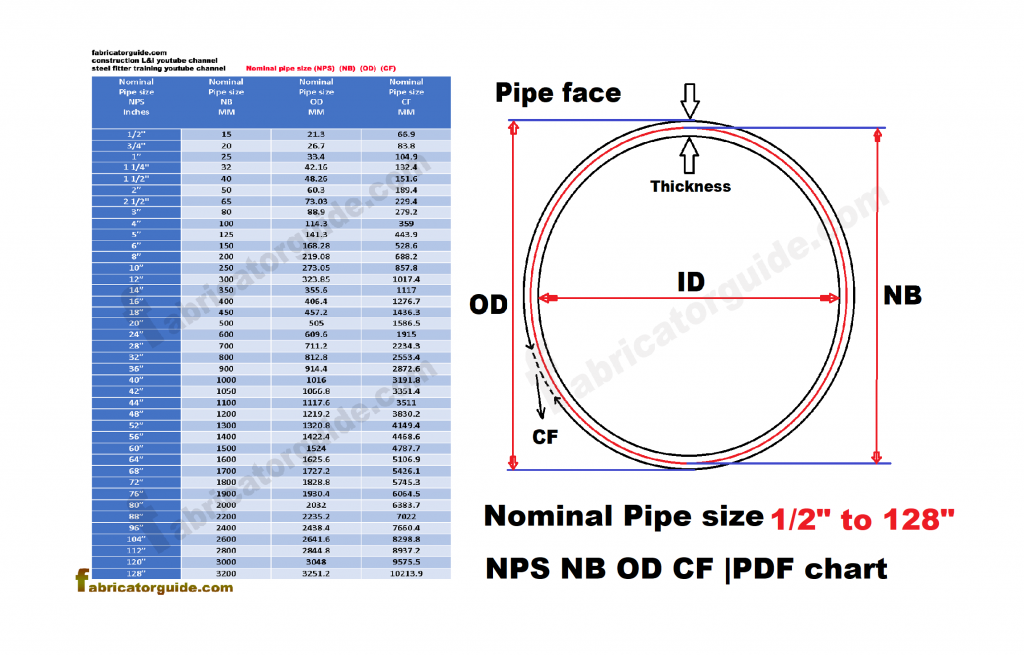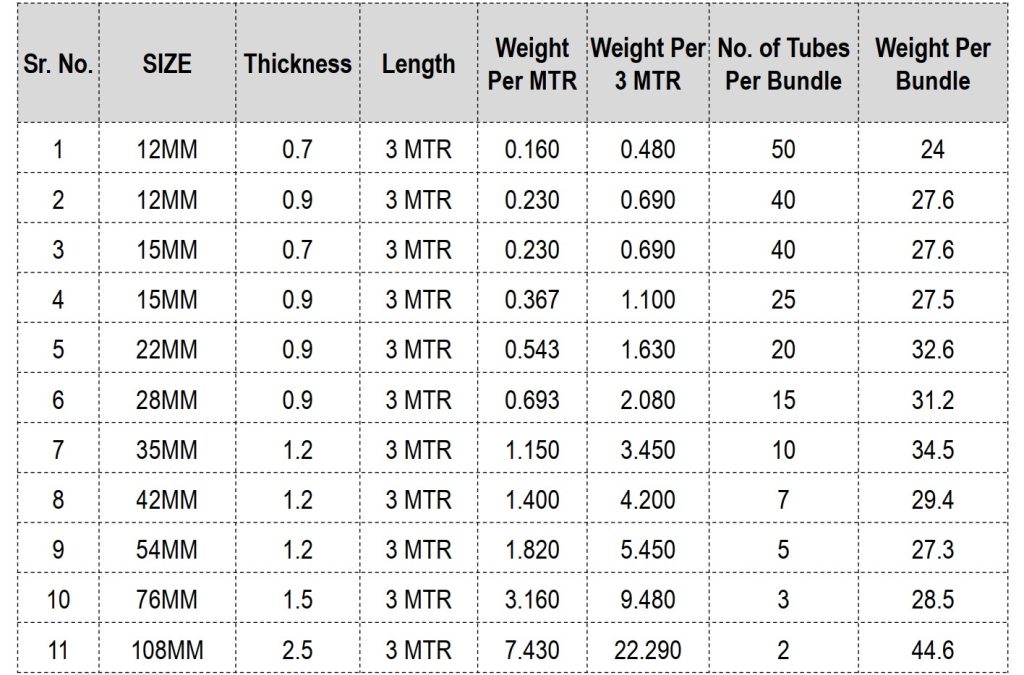Have you ever found yourself staring at a plumbing diagram, wondering how to convert those seemingly familiar inch measurements into the more universally used metric system? Or perhaps, you’re embarking on a DIY project and need to ensure that your chosen pipe perfectly fits your planned setup. If you’ve uttered words like “1 1/2 inch pipe to mm,” then you’ve stumbled upon a common dilemma in the world of pipe fittings and construction.

Image: fabricatorguide.com
Converting inches to millimeters, or vice versa, isn’t always intuitive. This guide will break down the conversion process, helping you understand the connection between these units, and equip you with the tools to confidently handle your next plumbing or construction project. Whether you’re a seasoned professional or a weekend warrior, mastering this conversion is essential for achieving accuracy and ensuring seamless project execution.
Deciphering the Fundamentals: Inches and Millimeters
Before delving into the conversion process, let’s establish the basics. The inch (in) and the millimeter (mm) are both units of measurement for length, but they hail from different measurement systems. The inch is part of the imperial system, prevalent in the United States and a few other countries, while the millimeter is a cornerstone of the metric system, dominating the rest of the world.
One inch is equivalent to 25.4 millimeters. This simple equation is the key to translating between the two systems, allowing us to bridge the gap between inches and millimeters effortlessly. This conversion factor is universal and forms the foundation for any inch-to-millimeter calculation.
Understanding the Concept of Pipe Size
When we talk about pipe size, we’re actually referring to the **nominal pipe size (NPS)**. This isn’t a direct measurement of the pipe’s inner or outer diameter. NPS is a standardized system used to categorize different pipe sizes, based on historical practices and industry conventions.
In the case of a 1 1/2 inch pipe, its **nominal pipe size (NPS)** is 1 1/2 inches. This refers to the theoretical size assigned to this category of pipe. However, the actual outer diameter, also known as the **outside diameter (OD)**, can differ slightly depending on the pipe’s schedule, which refers to the thickness of the pipe wall.
Delving into Pipe Schedules: A Key Factor in Conversions
Pipe schedules play a crucial role in determining the actual outer diameter and the corresponding conversion to millimeters for a given nominal pipe size. Here’s a breakdown of how it all connects:
Let’s look at common pipe schedules and their corresponding outer diameters:
- Schedule 40: This is a widely used schedule for general applications.
- Schedule 80: This schedule indicates a thicker pipe wall, often used for higher pressure applications.
- Schedule 160: This schedule features even thicker pipe walls, designed for demanding environments and critical applications.
To illustrate the influence of schedule, consider a 1 1/2 inch NPS pipe:
- Schedule 40: The OD is approximately 1.900 inches, which translates to about 48.26 millimeters after conversion.
- Schedule 80: The OD is approximately 2.375 inches, which translates to about 60.32 millimeters in the metric system.
- Schedule 160: The OD is approximately 2.875 inches, translating to about 73.02 millimeters.
As you can see, the outer diameter (OD), and thus the corresponding millimeter conversion, varies significantly across different schedules, underscoring the importance of understanding the pipe’s intended application and its corresponding schedule.

Image: elchoroukhost.net
The Conversion Process: Making Inches Speak Millimeters
Now that we’ve explored the fundamentals of inch and millimeter conversions, let’s dive into the practical aspects of transforming those inch measurements into millimeters.
To convert any inch measurement to millimeters, simply multiply the inch value by 25.4. For example, to convert 1 1/2 inches to millimeters, first express the mixed fraction as a decimal: 1.5 inches.
Next, multiply by 25.4: 1.5 inches x 25.4 mm/inch = 38.1 millimeters.
However, remember that the conversion for 1 1/2 inch pipe to mm is more complex and requires considering the pipe’s schedule. Therefore, it’s crucial to consult a pipe schedule chart or an online conversion tool to obtain the accurate conversion based on your specific pipe schedule.
The Importance of Precision: Why Conversions Matter
You might be thinking, “Why bother with these conversions? Can’t I just use inches?” While it might seem like a minor detail at first, converting to millimeters is crucial for numerous reasons, especially when working with global standards.
In a world increasingly reliant on interconnected systems and international collaboration, understanding metric measurements is essential. Whether you’re working on a project employing materials sourced globally, collaborating with international teams, or simply wanting to ensure consistency in your work, the ability to fluently convert between inches and millimeters is a valuable skill.
Furthermore, understanding metric conversions can enhance safety and prevent costly errors in the construction and industrial sectors. Misinterpreting measurements can lead to compatibility issues, material waste, and even potential safety hazards. Adopting accurate conversion practices can eliminate these risks, ensuring projects are completed efficiently, cost-effectively, and most importantly, safely.
Using Online Resources for Easy Conversion
Thankfully, many online tools are available to simplify the conversion process and reduce the likelihood of manual calculation errors. Numerous websites offer dedicated conversion calculators specifically for pipe sizes.
These online calculators are designed to be user-friendly and provide accurate conversions tailored to your specific requirements. Simply input the nominal pipe size, the desired schedule, and the tool will instantly calculate the corresponding millimeter measurement, eliminating the need for manual calculations and ensuring accuracy.
Tips for Accurate and Efficient Conversions
Regardless of whether you opt for manual calculations or online resources, here are some helpful tips for converting 1 1/2 inch pipe to mm or any other pipe dimension:
- Always Confirm the Pipe’s Schedule: The pipe’s schedule is crucial for accurate conversion. Always verify the schedule before performing any conversions.
- Use Reliable Conversion Tools: Utilize reputable online conversion calculators to eliminate the possibility of manual errors. Check for websites specializing in pipe size conversions.
- Double-check Your Results: It’s always a good practice to double-check your results, especially when dealing with crucial measurements. A small error in conversion can lead to costly mistakes later on.
- Refer to Industry Standards: Consult industry standards and regulations relevant to your specific project for accurate and compliant conversions.
1 1 2 Inch Pipe To Mm
Conclusion
Converting 1 1/2 inch pipe to mm might seem like a small detail at first, but it plays a vital role in ensuring accuracy, efficiency, and safety in various applications. By understanding the fundamental principles of inch-to-millimeter conversion, the influence of pipe schedule, and utilizing reliable conversion tools, you can navigate the world of pipe sizes with confidence.
Whether you’re a seasoned professional or a weekend DIY enthusiast, mastering conversions will equip you with the knowledge to seamlessly integrate with global standards, minimizing the risk of costly errors and ensuring your projects are completed successfully.
So, the next time you encounter a pipe size specified in inches, remember the invaluable connection to millimeters. Equip yourself with the knowledge, utilize the available tools, and confidently convert to the metric system with ease.






